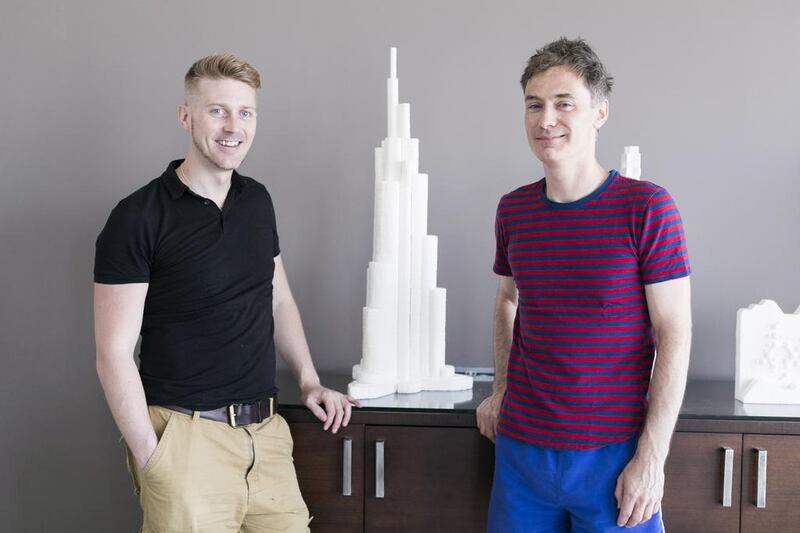For a man whose work is predicated on the sweeter side of life, there is nothing remotely saccharine about Brendan Jamison’s conversation.
As the artist reflects on a 13-year-long career, during which he and fellow sculptor Mark Revels have dedicated themselves to creating fantastical structures out of nothing more than household sugar cubes, Jamison’s conversation turns from biology, medicine and material science to engineering, architecture, city planning and art.
“About 10 years ago, everyone was talking about the dangers associated with fat, but now they’re talking about sugar and because of that we get invited to do projects that help to highlight the associated health risks,” the softly-spoken Ulsterman says in advance of his appearance at the Think Science Fair 2017, a youth-focused science and technology event that opens at the Dubai World Trade Centre on April 18.
The idea, Jamison explains, is to use the crystalline confections in a series of construction workshops to encourage children and teenagers to explore their dreams for Dubai’s urban future, while also engaging them in conversations about the links between diet, sugar and diabetes.
“The whole focus is to try to encourage teenagers to imagine a city of the future and the kind of buildings they would like to construct, so we’ve been trying to create different styles of architecture in our installation,” he says.
In preparation for the event, the men spent three weeks in their studio in Belfast, Northern Ireland, and three weeks in a Dubai hotel room carving, glueing and assembling a sugar metropolis. It includes organic, twin towers that rise like termite mounds, top-heavy towers made from blocks that decrease in size as they near ground and others that ripple like waves.
The stars of the show, however, are scale versions of the Burj Khalifa, the Burj Al Arab and Skidmore, Owings & Merrill’s twisting Cayan Tower.
Made from 5,040 sugar cubes, the Burj Khalifa took Mark Revels three weeks to carve and construct, providing the sculptors with numbers and statistics that allow the artists to explore what Jamison describes as “sugar equations”.
“At two grams of carbohydrate [per cube], that’s the equivalent of 10,080 grams of carbohydrate for the whole tower,” the artist explains. “Given that the insulin-to-carb ratio is 1:15, that means it would take 72 units of rapid-action insulin to offset that amount of sugar, if it was consumed by a human.”
The lengthy construction time, Jamison says, is a result of the surprising difficulty and hardness of the material.
“It’s extremely difficult to cut and carve sugar cubes. It took several years and a lot of experimentation with different adhesives as well,” he explains, declining to reveal the techniques that have taken more than a decade to perfect.
“There are lots of links between art and science in that respect, because there’s been lots of experimentation and trial and error, so we always see those links,” he says.
“But when people come and see these sculptures, there’s a certain magic; they’re usually quite blown away by the thought that the structures can stand and I think it would probably take away from that magic if we revealed too much.”
In combining architectural icons and confectionery, Jamison and Revels appear to have come up with a project that is tailor-made for the UAE, a country whose appetite for headline-grabbing megastructures and belt-busting desserts is outstripped only by its record-breaking incidence of diabetes, a chronic disease that is now a global phenomenon.
The international scope of the issue and the sweet tooth that curators, educators and health campaigners have developed for Jamison and Revels’ work has also allowed the artists to travel the world.
In 2010, for the London Festival of Architecture, they created an 1.8 metre-long sculpture of Tate Modern, which took nine months to complete. They have also completed major installations in Beijing and Kiev, at the Pompidou Centre in Paris and at the appropriately-named Sugar Hill Development in Harlem, New York, where they created a metropolis from a quarter of a million sugar cubes.
The appeal, Jamison thinks, stems from sugar’s very tactile and democratic qualities, characteristics that allow the artists to reach out to their audiences in ways that wouldn’t be possible with traditional materials.
“It puts me off ever going into making sculpture out of bronze or wood because those kind of materials don’t have that same emotional impact,” says Jamison.
“It’s probably because it’s a very domestic product that people can associate with and relate to. They don’t feel there’s any kind of hierarchy between them and the material, so they feel completely at ease.”
• Sugar Science, a collaborative sculpture installation by Brendan Jamison and Mark Revels, supported by the British Council, is at the Think Science Fair 2017 at Dubai World Trade Centre from today until Thursday. www.thinkscience.ae
nleech@thenational.ae





